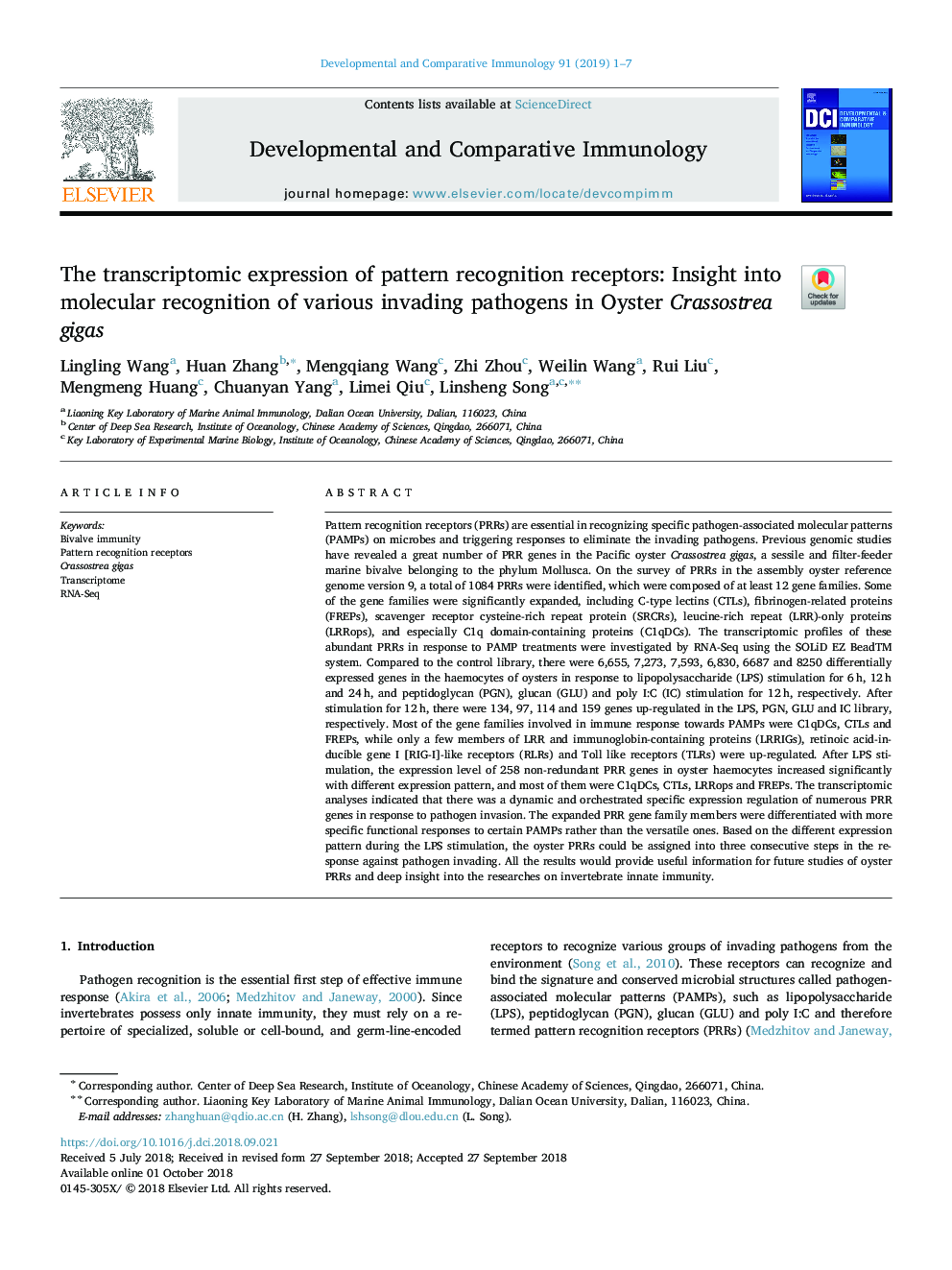| کد مقاله | کد نشریه | سال انتشار | مقاله انگلیسی | نسخه تمام متن |
|---|---|---|---|---|
| 11010710 | 1806783 | 2019 | 7 صفحه PDF | دانلود رایگان |
عنوان انگلیسی مقاله ISI
The transcriptomic expression of pattern recognition receptors: Insight into molecular recognition of various invading pathogens in Oyster Crassostrea gigas
دانلود مقاله + سفارش ترجمه
دانلود مقاله ISI انگلیسی
رایگان برای ایرانیان
کلمات کلیدی
موضوعات مرتبط
علوم زیستی و بیوفناوری
بیوشیمی، ژنتیک و زیست شناسی مولکولی
زیست شناسی تکاملی
پیش نمایش صفحه اول مقاله

چکیده انگلیسی
Pattern recognition receptors (PRRs) are essential in recognizing specific pathogen-associated molecular patterns (PAMPs) on microbes and triggering responses to eliminate the invading pathogens. Previous genomic studies have revealed a great number of PRR genes in the Pacific oyster Crassostrea gigas, a sessile and filter-feeder marine bivalve belonging to the phylum Mollusca. On the survey of PRRs in the assembly oyster reference genome version 9, a total of 1084 PRRs were identified, which were composed of at least 12 gene families. Some of the gene families were significantly expanded, including C-type lectins (CTLs), fibrinogen-related proteins (FREPs), scavenger receptor cysteine-rich repeat protein (SRCRs), leucine-rich repeat (LRR)-only proteins (LRRops), and especially C1q domain-containing proteins (C1qDCs). The transcriptomic profiles of these abundant PRRs in response to PAMP treatments were investigated by RNA-Seq using the SOLiD EZ BeadTM system. Compared to the control library, there were 6,655, 7,273, 7,593, 6,830, 6687 and 8250 differentially expressed genes in the haemocytes of oysters in response to lipopolysaccharide (LPS) stimulation for 6â¯h, 12â¯h and 24â¯h, and peptidoglycan (PGN), glucan (GLU) and poly I:C (IC) stimulation for 12â¯h, respectively. After stimulation for 12â¯h, there were 134, 97, 114 and 159 genes up-regulated in the LPS, PGN, GLU and IC library, respectively. Most of the gene families involved in immune response towards PAMPs were C1qDCs, CTLs and FREPs, while only a few members of LRR and immunoglobin-containing proteins (LRRIGs), retinoic acid-inducible gene I [RIG-I]-like receptors (RLRs) and Toll like receptors (TLRs) were up-regulated. After LPS stimulation, the expression level of 258 non-redundant PRR genes in oyster haemocytes increased significantly with different expression pattern, and most of them were C1qDCs, CTLs, LRRops and FREPs. The transcriptomic analyses indicated that there was a dynamic and orchestrated specific expression regulation of numerous PRR genes in response to pathogen invasion. The expanded PRR gene family members were differentiated with more specific functional responses to certain PAMPs rather than the versatile ones. Based on the different expression pattern during the LPS stimulation, the oyster PRRs could be assigned into three consecutive steps in the response against pathogen invading. All the results would provide useful information for future studies of oyster PRRs and deep insight into the researches on invertebrate innate immunity.
ناشر
Database: Elsevier - ScienceDirect (ساینس دایرکت)
Journal: Developmental & Comparative Immunology - Volume 91, February 2019, Pages 1-7
Journal: Developmental & Comparative Immunology - Volume 91, February 2019, Pages 1-7
نویسندگان
Lingling Wang, Huan Zhang, Mengqiang Wang, Zhi Zhou, Weilin Wang, Rui Liu, Mengmeng Huang, Chuanyan Yang, Limei Qiu, Linsheng Song,